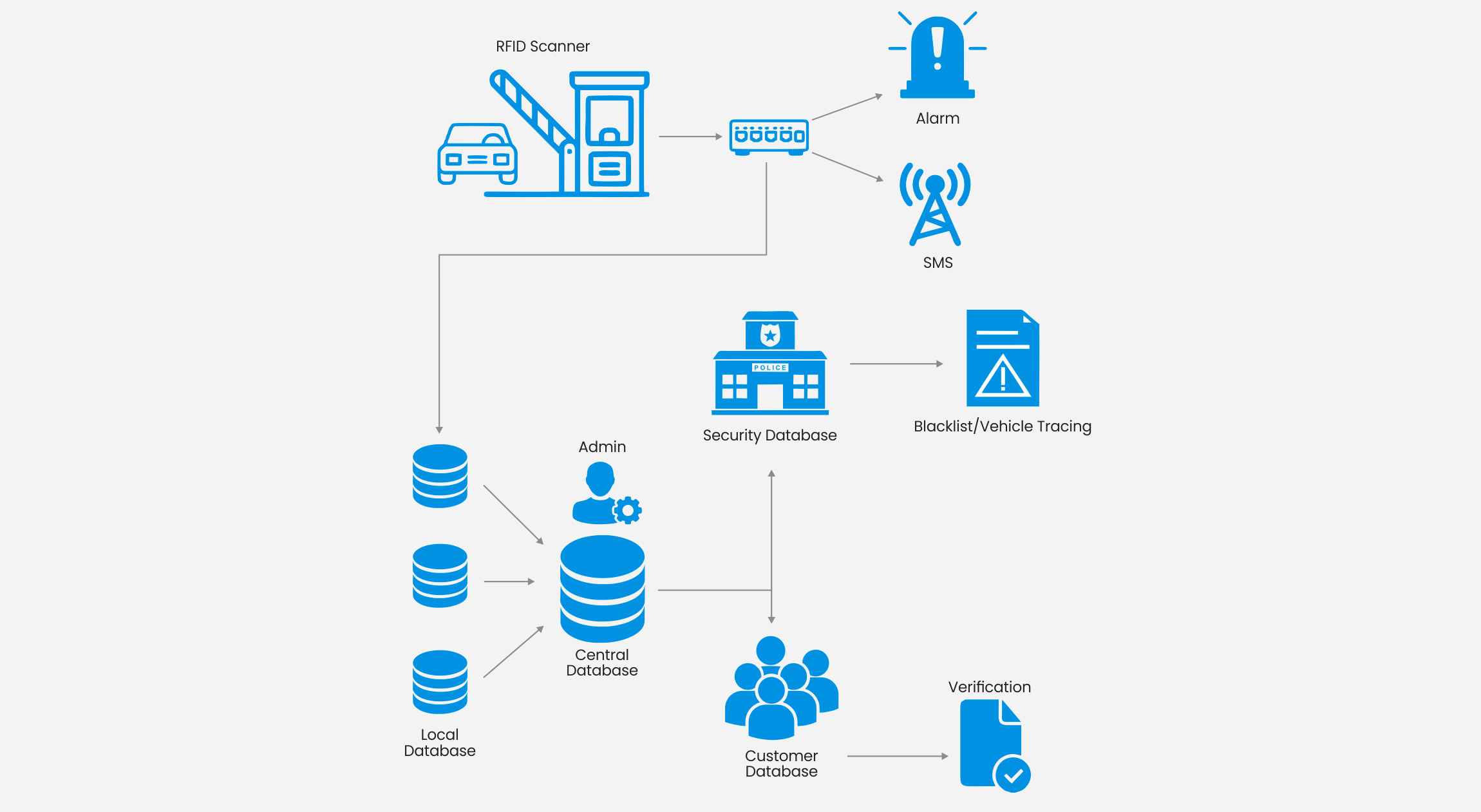Electronic Toll Collection (ETC) is a technology-driven system that automates the processes of collecting tolls or fees on highways and bridges. Instead of traditional manual toll collection methods where drivers stop and pay in cash, ETC utilizes systems to streamline and hasten the process.
In an ETC system, vehicles are equipped with electronic toll tags or transponders, which communicate with toll collection infrastructure such as overhead gantries equipped wit sensors and antennas. As a vehicle with a functional ETC tag passes through the toll point, the system automatically deducts the toll amount from the drivers prepaid account.
ETC is an efficient and time-saving process which reduces unwanted congestion at toll points thereby improving overall toll collection management.
Understanding an Electronic Toll Collection System
As a vehicle approaches the toll plaza, the radio-frequency (RF) field emitted from the antenna activates the transponder.The transponder broadcasts a signal back to the lane antenna with some basic information.The information is transferred from the lane antenna to the central database.
If the account is in good standing, a toll is deducted from drivers prepaid account.The gate opens and green light indicates the driver can proceed.

Key Parts of an ETC
♢ On-Board Unit: An electronic device installed in a vehicle that communicates with the tolling infrastructure which consists of technology like RFID, DSRC or GPS for toll detection and identification.
♢ On-Road Unit: On road infrastructure that includes toll booths, gantries and associated components. Consists of RFID readers, antennas and cameras which are commonly used for toll collection and vehicle identification.
♢ Back-end Server: This consists of centralized servers that manage the system data by storing user account information, transaction records and toll rates. These system process transactions in real-time, calculates toll and generates reports.
♢ Communication Networks: This consists of a reliable and secure mode of communication between the on-board unit and the back-end server. Utilizes technology like cellular networks, DSRC and RFID.
♢ Payment Processing Systems: A key interface for handling financial transactions related to toll collection by integrating various payment methods including cards, electronic wallets and other payment gateways.
♢ Data Analytics and Reporting Tools: These includes data processing softwares that assimilate large scale data to generate reports on traffic patterns, system performance and revenues. This information is useful for large scale decision making and system optimization.
Challenges in Deploying an Electronic Toll Collection (ETC) unit
Infrastructure & Integration
Integrating ETC systems with existing toll infrastructure can be challenging, requiring upgrades or modifications to ensure seamless communication and interoperability.The RFID readers, and cameras employed in different Electronic Toll Collection (ETC) systems may utilize serial, I/O, or Ethernet connections. To relay data to a SCADA system, these components must link to an IP network. To ensure the system’s functionality, sensor data must undergo verification against stored vehicle records and license plate numbers within databases. Considering factors like size, mounting options, functional integration levels, and, notably, the reliability of communication devices is crucial for installations in compact roadside cabinets. Opting for robust systems helps minimize operating costs over the equipment’s lifecycle, particularly important given their deployment in challenging outdoor conditions.
Data Security
Stringent cyber security frameworks need to be adopted to ensure that critical user information is not accessible to fringe elements. ETC systems being an integral part of public transportation infrastructure, the choice of devices should meet cybersecurity standards. It is also necessary to use secure protocols when transmitting data such as payments and user information to prevent unauthorized access, data theft and tempering of records.
System Maintenance
ETC systems require regular maintenance to ensure proper functionality. Harsh environmental conditions, extreme weather and chances of vandalism should be factored in while choosing the devices to setup the ETC system. The systems should also be set up with built-in fault tolerance to ensure uninterrupted operations.
Network Availability and Performance
ETC systems hinge on consistent network performance. The occurrence of packet loss in the transmission process can compromise data integrity, leading to inaccuracies in toll collection. It is essential for the network to possess adequate bandwidth to avoid packet loss. Network redundancy mechanism shall also be employed to avoid network downtime.
Moxa Connectivity and Networking Products for Secure and seamless ETC
As a leading provider of industrial connectivity and networking solutions, Moxa products pivotal role in establishing robust networks for cutting-edge Electronic Toll Collection systems. Explore the collection of Moxa products and get in touch with our expert team to discover dependable communication solutions to smart ETC systems.
Conclusion
A seamless integration of existing toll collection systems with secure and consistent connectivity is paramount to an efficient Electronic Toll Collection system. As we navigate the landscape of intelligent transportation, the reliability of these systems becomes linchpin for enhancing efficient toll collection, reducing traffic congestion and improving overall commuter experience. Bu leveraging Moxa’s cutting-edge solutions, we not only ensure a robust toll collection infrastructure but also fortify the system against potential vulnerabilities.

